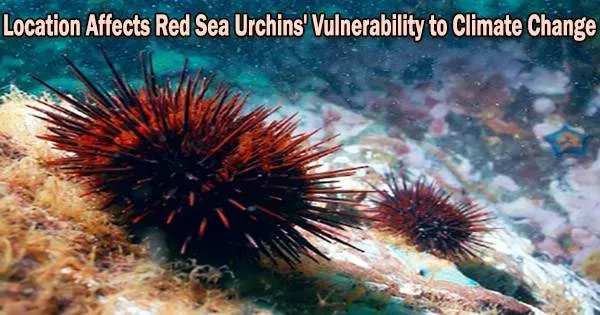The vulnerability of red sea urchins to climate change can vary depending on their location. Factors such as water temperature, acidity, and food availability can all play a role in determining the susceptibility of red sea urchins to the effects of climate change in a particular area.
A recent investigation of the red sea urchin, a species with high commercial value, looked into how various populations react to environmental changes. The findings demonstrate that red sea urchin populations in Northern and Southern California are evolved to their local environments, but they differ in their susceptibility to environmental changes anticipated in the future as a result of ocean acidification and climate change.
Red sea urchin populations in Southern California may be more susceptible to climate change than those in Northern California, according to the most recent research, which was released on January 20 in Science Advances.
The researchers believe that even while the sea urchins in Southern California are already accustomed to warmer temperatures, further warming of their environment might be more than they can handle.
“Red sea urchins from the Southern California population were much more sensitive to environmental changes than those from Northern California, and we think that is likely because they are already closer to some kind of thermal limit,” said senior author Kristy Kroeker, professor of ecology and evolutionary biology at UC Santa Cruz.
First author Emily Donham led the study as a UCSC graduate student and is now a postdoctoral scholar at UC Santa Barbara.
“Red sea urchins are an important fishery species along our coast, so understanding how they are likely to be impacted by climate change is very important,” she said.
Red sea urchins from the Southern California population were much more sensitive to environmental changes than those from Northern California, and we think that is likely because they are already closer to some kind of thermal limit.
professor Kristy Kroeker
The study looked at the effects of three key environmental variables in the sea urchins’ coastal habitat: water temperature, dissolved oxygen, and pH (a measure of ocean acidification). Oceans are warming and losing oxygen as a result of climate change brought on by increased atmospheric carbon dioxide, while ocean acidification is a result of increased saltwater absorption of carbon dioxide.
Kroeker claims that the majority of research examining how well organisms adapt to climate change have concentrated on a single component of environmental change, such as warming or ocean acidification. “But all of these species that we are concerned about are embedded in environments with multiple variables that will be affected by climate change,” she said.
The researchers initially described the current conditions in Northern and Southern California’s kelp forests using a network of sensors placed along the coast. Due to the considerable seasonal upwelling that brings cold, deep waters with lower pH (closer to the acidic end of the scale) and dissolved oxygen levels to the surface in the north, the coastal waters of Northern and Southern California differ greatly from one another. Coastal upwelling is much weaker in Southern California.
Because of this, Northern California’s sea urchin populations are already subject to waters that are colder, less oxygenated, and more acidic than those in Southern California. But compared to the present, the seas in both locations will be warmer, more acidic, and less oxygenated in the future.
The researchers raised young sea urchins from the two regions in outdoor tanks at UCSC’s Long Marine Laboratory, where they could regulate the environmental conditions in each tank, to examine the red sea urchins’ sensitivity to these shifting environments.
The trials exposed sea urchins from both populations to the typical temperature, dissolved oxygen, and pH conditions in the two areas. The findings unmistakably demonstrated that red sea urchin populations are adapted to their native settings and suffer higher mortality rates when raised under new circumstances. Southern California sea urchins fared poorly under Northern California conditions, and vice versa.
In accordance with regional climate forecasts for the year 2100, the researchers also exposed red sea urchins to the future circumstances anticipated for their native regions. The range of circumstances now measured along the shore generally does not overlap with these anticipated conditions.
The Northern California sea urchins suffered reduced mortality and had better body condition than the Southern California sea urchins, despite the fact that mortality rose in populations from both regions under the anticipated future conditions.
“Despite the Northern California populations being in more acidic, lower-oxygen conditions in the future, it was the Southern California populations that were much more impacted,” Kroeker said.
She remarked that this was unexpected given that inhabitants in Northern California are accustomed to seasonal variations in which temperature, dissolved oxygen, and pH all fall at the same time. However, with climate change, this closely related variation, or “covariance structure,” will be disrupted. Dissolved oxygen and pH will decrease further, but the temperature will increase.
“It’s breaking down the environmental covariance structure they’re adapted to, so our prediction was that this would make them more vulnerable. But that’s not what we found,” Kroeker said.
According to the research, water temperature is an important environmental factor for red sea urchins. Because Southern California’s coastal waters were already warmer to begin with, it might not take much more warming for them to become unfriendly to red sea urchins.
“We should not assume that a species’ vulnerability to climate change is the same across its whole range,” Kroeker said. “Each population is adapted to local conditions, and not all populations are going to respond similarly to global climate change.”
In addition to Donham and Kroeker, the coauthors include Iris Flores, Alexis Hooper, and Evan O’Brien at UC Santa Cruz; Kate Vylet and Jan Freiwald at Reef Check Foundation; and Yuichiro Takeshita at Monterey Bay Aquarium Research Institute. This work was supported by the UC Institute for the Study of Ecological and Evolutionary Climate Impacts (ISEECI) and the California Ocean Protection Council.





